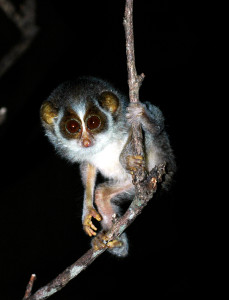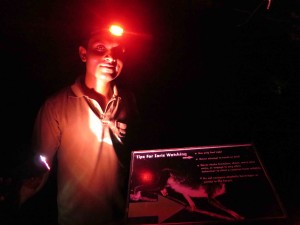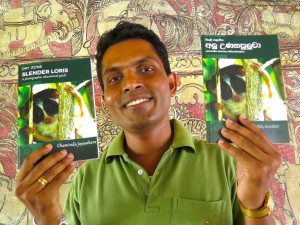Vil Uyana’s Red Light District – Slender Loris Watching
by Jetwing · Published · Updated
 The moon vanished behind the clouds and a thin whistle like call indicated the male Slender Loris is around, a rare clown like monkey that probably got its name from The Dutch that saw the species as the jungle jester. An adorable monkey with a clown like over sized head and big saucer like eyes. The quiet whistle can I am told by the naturalist be heard between 75 to 100 metres away by the male Loris in search of a jungle mate. Despite the fact that in April/ May the female Lorises are giving birth after five and a half months pregnancy, there is still plenty of monkey action on the natural Loris trail that has become Vil Uyana’s hotel’s star attraction. With the likes of the BBC and National Geographic spending two weeks documenting the lives of the Loris interest is only going to grow on a colony that has gone from only two to over 16 in less than 5 years.
The moon vanished behind the clouds and a thin whistle like call indicated the male Slender Loris is around, a rare clown like monkey that probably got its name from The Dutch that saw the species as the jungle jester. An adorable monkey with a clown like over sized head and big saucer like eyes. The quiet whistle can I am told by the naturalist be heard between 75 to 100 metres away by the male Loris in search of a jungle mate. Despite the fact that in April/ May the female Lorises are giving birth after five and a half months pregnancy, there is still plenty of monkey action on the natural Loris trail that has become Vil Uyana’s hotel’s star attraction. With the likes of the BBC and National Geographic spending two weeks documenting the lives of the Loris interest is only going to grow on a colony that has gone from only two to over 16 in less than 5 years.
Finding them requires patience as the only other clue is the bright red eyes that look back at me through the trees when spotted with red head lamps and a torch with a red filter, or night vision goggles all of which are used, to avoid frightening the incredibly shy animal and are the only sure way to spot these elusive creatures. By turning this fascinating forest and bamboo area into an infra red zone you study the island’s smallest recorded primate in more detail and the local lizard population. Unlike the other monkeys the slender Loris is tailless so there is no Tarzan and Jane swinging action more like a 15-minute cuddle.
An average Loris grows to about 8 inches in length and weighs between170 to 230 grams. It has incredible hearing and it’s spindly like arms allow them to walk across even the smallest branch, twigs in some cases without snapping them. Jetwing Vil Uyana is considered such an outstanding wetlands project that each year as you will see from the nature stats it is attracting more wildlife back into this agricultural dry zone, once the playground of the Kings, whose great rock Fortress Sigriya dominates the surrounding area.
 Chaminda Jayasekara Jetwing’s youngest naturalist has studied these adorable monkeys for the last five years and converted his research into an outstanding photographic educational guide and a fascinating nocturnal safari tour that takes us into the mysterious world of these shy, reclusive creatures, that live off insects and small geckos, and mark their territory with putrid scented urine to put others off and hide behind foliage if disturbed. As they have acute hearing it is imperative to stay quiet at all times, not smoke a cigarette, and switch off phones so not to disturb them in any way. This way you might even see the ‘Silent killer’ in action catching an insect, which is nearly as exciting as a leopard kill. In the nocturnal world their slow motion movements always give the element of surprise to kill a grasshopper or moth is incredible to watch and the reason they received this name. Their nightly activities start around 6.45 pm, when they come out of their ball like sleep, with their heads between their legs, to eat. For around two hours they are at their most active.
Chaminda Jayasekara Jetwing’s youngest naturalist has studied these adorable monkeys for the last five years and converted his research into an outstanding photographic educational guide and a fascinating nocturnal safari tour that takes us into the mysterious world of these shy, reclusive creatures, that live off insects and small geckos, and mark their territory with putrid scented urine to put others off and hide behind foliage if disturbed. As they have acute hearing it is imperative to stay quiet at all times, not smoke a cigarette, and switch off phones so not to disturb them in any way. This way you might even see the ‘Silent killer’ in action catching an insect, which is nearly as exciting as a leopard kill. In the nocturnal world their slow motion movements always give the element of surprise to kill a grasshopper or moth is incredible to watch and the reason they received this name. Their nightly activities start around 6.45 pm, when they come out of their ball like sleep, with their heads between their legs, to eat. For around two hours they are at their most active.
 Having given birth around April/May, as recorded by the naturalist, female Loris’s carry their young under their abdomens in the belly area for 2 months and in nearly all cases have only one baby a year, although Chaminda has been lucky enough to see twins and document their lives first hand. The area of Loris activity has expanded in numbers from only a couple of Loris observed in 2010 to over 16 Slender Loris today. At the end of a night tour, that takes in nocturnal bird life, wild cats including the civets, lizards and bats, one can enjoy the excellent Loris conservation centre, covering all the facts, set in the most iconic eco resort ever created and for me a fascinating journey as I first came to the site when it was abandoned agricultural land and so to have achieved all this in ten years is to me personally almost unimaginable.
Having given birth around April/May, as recorded by the naturalist, female Loris’s carry their young under their abdomens in the belly area for 2 months and in nearly all cases have only one baby a year, although Chaminda has been lucky enough to see twins and document their lives first hand. The area of Loris activity has expanded in numbers from only a couple of Loris observed in 2010 to over 16 Slender Loris today. At the end of a night tour, that takes in nocturnal bird life, wild cats including the civets, lizards and bats, one can enjoy the excellent Loris conservation centre, covering all the facts, set in the most iconic eco resort ever created and for me a fascinating journey as I first came to the site when it was abandoned agricultural land and so to have achieved all this in ten years is to me personally almost unimaginable.
Vil Uyana was created out of 24 acres of abandoned agricultural land, three acres of which are now entirely designated as a Loris conservation area with clearly marked trails. Information stands can be found at key points and fascinating facts on these charismatic creatures are, as I discovered on a night walk, mesmerising to watch.
Jetwing Vil Uyana I learn from the naturalist who also does early morning wildlife tours is also home to 20 species of mammals, 116 species of birds (this has gone up by four new types of birds have been sighted since last year showing how the environment is continually improving for the natural world) and 35 species of amphibians and reptiles including a very big crocodile that migrates from the river by the hotel restaurant to cooler areas during the windy dry period. He is a popular sight, jumping in the air to eat his fish whole and snapping his jaws in spectacular ways that have given him star status in this 30 dwelling hotel that has a mixture of luxury unique habitats for the guests to stay in ranging from being situated on water, or in the forest, paddy fields, marsh or garden. Each one high lights how Jetwing is ail about protecting our natural assets for future generations and Tourism For Tomorrow.



